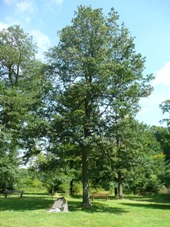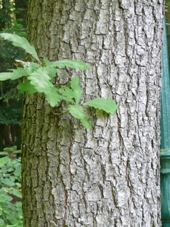Oak (Quercus spp.)
Oak (Quercus spp.) belong to the beech family (Fagaceae).
Natural range
Oaks are found in all parts of the northern hemisphere, in Europe mostly as the common oak (Quercus robur). In Germany, the oak makes up 9 per cent of the tree population, making it the second most widespread deciduous species after the beech, and can mostly be found in mixed forests and woodlands. The main habitat of the higher value Sessile or Durmast oak lies in lower mountainous or hilly regions. It grows in the central German uplands and also in the southern Alps.
Description of the wood
Oaks are summer-green or evergreen trees, which can develop branch-free trunks of up to 15 metres high and diameters ranging from 40 cm to over a metre in favourable growing conditions. Bushes are rarer. The roughly 2½ to 5 cm creamy to light-brown sapwood of native oak trees stands out clearly from the greyish-yellow to yellowish brown heartwood, which darkens even more later. Oaks are ring-porous deciduous trees, in which spring and summerwood in the annular rings are clearly distinguishable, and the wood in general is characterised by a prominent, open grained or streaky surface. This typical grain pattern is caused by the particularly large rays on the surface of wood cut in a radial direction. It is neither macroscopically nor microscopically possible to differentiate reliably between the Common oak and the Sessile oak.
Properties
The wood of the Sessile and Common oaks is characterised by its strength, elasticity and high resistance to wear. With an average basic density of 0.71 g/m§, oak ranges from moderately heavy to heavy and hard. Due to the annular ring structure of this deciduous wood, its hardness increases with the increasing width of the rings, as the proportion of summerwood rises in relation to the relatively constant proportion of springwood.
Workability
Oak wood can generally be worked easily and cleanly with all manually and mechanically operated tools, though any work with knives, saws or cleavers requires great care and very sharp tools. With the exception of the very hard varieties, oak can be sawn, profiled and drilled very well, it is easy to plane, sand and cleave. Nail and screw joints are easy to make and they hold very well, and surface treatment poses no real problems. Care should be taken when oak comes into contact with ferrous metals, as this can often lead to black stains on the surface of the wood.
Durability
The heartwood is resistant to infestation by wood-destroying fungi (durability class 2) whereas oak sapwood is very susceptible (durability class 5).
Treatability
The heartwood of Common or Sessile oak is practically untreatable (treatability class 4 acc. to DIN EN 350-2), the sapwood, on the other hand, is permeable and easy to treat. (treatability class 1).
Applications
Solid oak has a wide range of uses: for heavy duty structures both internally, such as stairs, windows and doors, parquet floors, and externally for bridges, towers or masts. Water engineering and shipbuilding are traditional domains for oak. For good brandies and wines, oak barrels are the first choice. Rustic-style and elegant furniture is made of medium-hard oak and mild oak is used for making high-quality, attractive veneers. And finally, seasoned oak is in great demand as fuel, either in the form of wood or charcoal.



